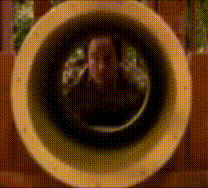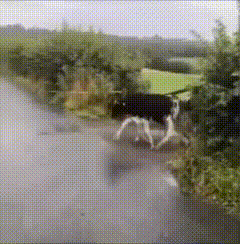TUNNEL THINKING and THE BLIND SPOT

For a species which only knows focusing – it is outside our imagination.
Focusing is Dominant
Focusing is by nature dominant. Among all animals, focusing has to be dominant in order to find food and reproduce.Humans used their brains to survive. We focused to learn, remember, and think. And abstract thought, whether rational or poetical, gave our imagination the ability to reach new understandings.
With our brilliant abstract focusing abilities we identified and eliminated the dangers. We made walls, warning signals, and weapons. We overcame the daily fears and insecurities which other animals have. We have no more need of panaral sensing.
The original use of panaral sensing is obsolete and redundant. It's useless for getting anywhere, doing anything, or being anyone. From our focused point of view, it seems like just doing nothing. It's pointless.
Focusing is creative and exciting, attractive and purposeful. Humans are more successful with focusing, than all other species. Why should we be interested in how other animals sense?
Tunnel Thinking
Focusing is always specific – it has to be. Focusing is always a form of inhibition.Focusing penetrates and is penetrant. It always has a converging tendency which gets narrower, always becoming more fragmented and making more connecting bridges.
Focusing has no natural tendency to divergence or wholeness it can only achieve these by association and coordination.
The Box
In every thought we have, a subject does something to an object – focused thought always needs to "complete the sentence" to be whole. In turn, every sentence we think re-confirms this mind-set and world-view.We built associations into a network of understanding. A safe box.
We have developed tunnel thought and live in our own echo chamber.
 Our cultural herd-understanding of life is complete within its own parameters. We've created an integrated picture of the world by excluding part of it. This is typical for all forms and degrees of closed-mindedness.
Our cultural herd-understanding of life is complete within its own parameters. We've created an integrated picture of the world by excluding part of it. This is typical for all forms and degrees of closed-mindedness.
And modern civilisation has cemented this world view by training focused sensing from the earliest age, and silently suppressing our panaral awareness.
Outside the Box
 Being panaral for safety, contradicts all our normal ideas on safety.
Being panaral for safety, contradicts all our normal ideas on safety. Human safety lies in a feeling of confirmation from herd mentality. At present, there is no confirmation of panaring from any herd or even small group.
Added to this, in this ironic age of individuality, few people have the ability to step outside the box, and do anything independent of herd mentality.
Panaring lies outside our experience and understanding.
Accepted Human Experience
When we have a panaral experience, when we see a panoramic view, or when interacting with nature – we interpret it as a response to the environment.So we take photos of the scenery. And if we start thinking about it, we focus on the memory of that landscape or river.
We fail to recognise that the landscape stimulated a different way of sensing which is actually independent of the environment. We just don't realise it. We suffer a form of self-fulfilling tunnel vision.
Modern humans only consciously train a limited horizontal part of their panaral vision when driving, but focusing dominates. We focus on where we're going, mirrors, maps, and signs. The "peripheral" vision is only subliminal... and then as soon as we notice something subliminally – we focus on it.
I imagine fighter pilots were trained panoramically in previous times. These days, i imagine they focus on radar display panels.
Adult humans never use their panaral senses actively, except perhaps some autistic people.
Natural Peoples
In traditional times, without ten years training of focusing talents, people would have had far more flexibility between the two sensory forms.Without walls blocking the view and lights flashing for attention, it would have been normal, on the hour-long walks to hunt or work, to just be casually panaral, nothing special, nothing worth talking about...
In preliterate times they had no words to distinguish between the different types of sensing.
Modern languages
Writing allowed language to diversify. However it wasn't until the late 1800s that European languages developed a descriptive word. And the Germanic languages only recognise a "peripheral" use of this way of sensing.Panoramic sensing describes the experience of a panorama. But even in modern times there is still no word to describe the way animals detect just the events happening, all the moving things, all the changes.
The lack of a clear, common, or scientific name always indicates a lack of cultural recognition.
Animal Studies
We should have rediscovered it by observing animals. But animal training and psychological research are only interested in animals' abilities to focus and learn tricks, solve puzzles, develop memory, and abstract thought. They want to know if and how animals can learn human focusing abilities.And all the time, there was so much we could have been learning from them, and how they use their panaral senses.
Maybe it's too simple. Researchers seems to be looking for clever answers, new discoveries... but nothing which has been staring us in the face for centuries.
The Human Ego
To some extent it's human egoism. I often hear "i can do that already" and very probably most people have touched on the experience. But this "been there, done that" attitude, blocks openness to the full experience.Panaral sensing has as many different intensities as focusing. And I'm sure everyone has experienced it to some extent.
At one extreme, gazing out into the void when daydreaming, depressed, or stoned.
Then, when walking in nature, or when cycling round in a relaxed way, the lack of an intense focal point opens up a central area of the panaral field.
But animals always stay still, and their lives depend on it, it's an intense awareness, it's not a casual experience.
Cultural Information
There is a small start to research into "peripheral" vision from the modern psychological perspective.And some ancient cultures practised it.
Organised Religion
The panaral experience of oneness and peace is generally associated with religion, but in turn religion is generally associated with a higher focal point. So here again, panaring is outside our comprehension. (A few exceptions are noted below.)If we were to mould the idea into our beliefs and make it part of feeling like a complete individual... it wouldn't work... we'd still be focusing.
Mindfulness is usually applied to selective focusing on breathing or inner-body awareness, as with many other meditation practices searching for a higher state of consciousness. But intensive focused practices simply aren't conducive to panaral sensing.
Interstingly all religions originated outside i.e. the same place that panaral sensing originated. As religions became organised they started practising in churches and temples – indoors where outside disturbances are excluded and panaral sensing is superfluous.
Humans, even when spiritually motivated, have to be doing something, or going somewhere, anything but staying still.
Being Still and Waiting
To sit just waiting for anything and everything, with the ears and eyes open, and waiting for changes and movements has only rarely been practised.Once you've experienced it, you'll also find it described in many of the central Buddhist texts, notably The Middle Way.
Christianity seems to have the attitude that we're here to look after the animals, not the other way round. Christians generally seem to feel abomination at the idea we could learn something from animals... as though the next step would be public copulation. And though some Jesuits clearly have knowledge of the panara, they combine it with highly mystical practices.
Back to Chapter Three : Civilisation's Habitual Ruts
Back to THE PANORAMA SENSES Priority Pages